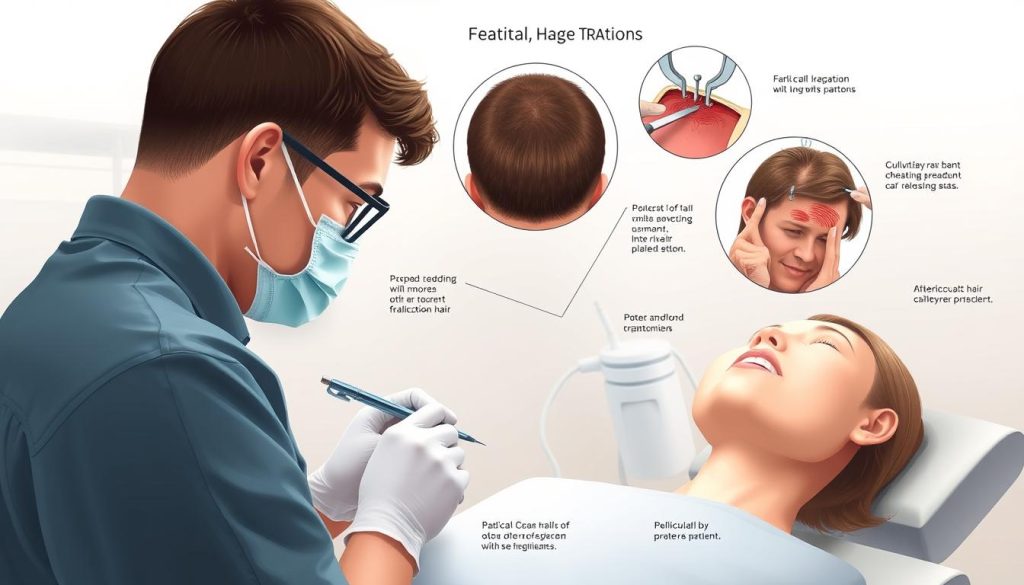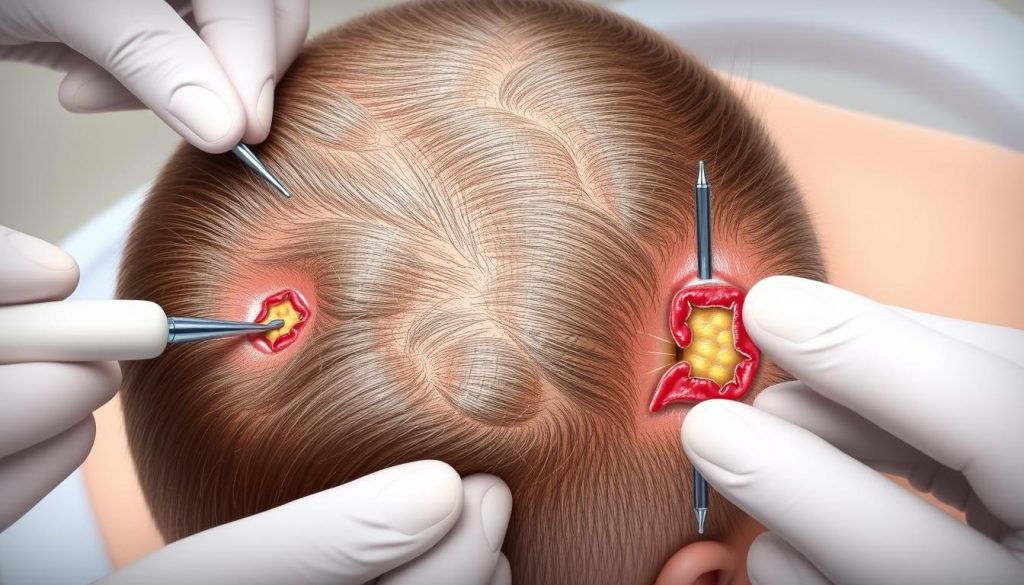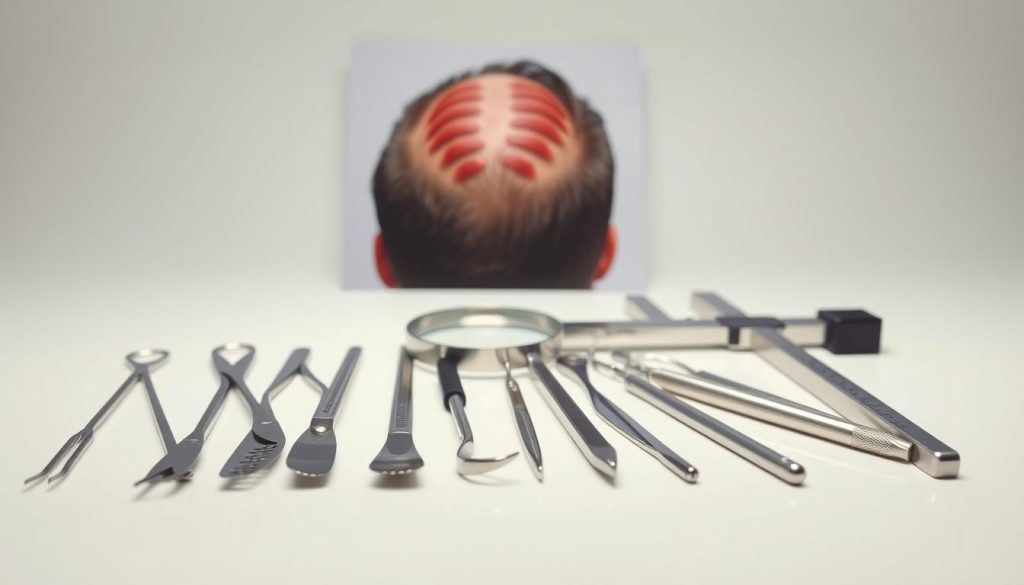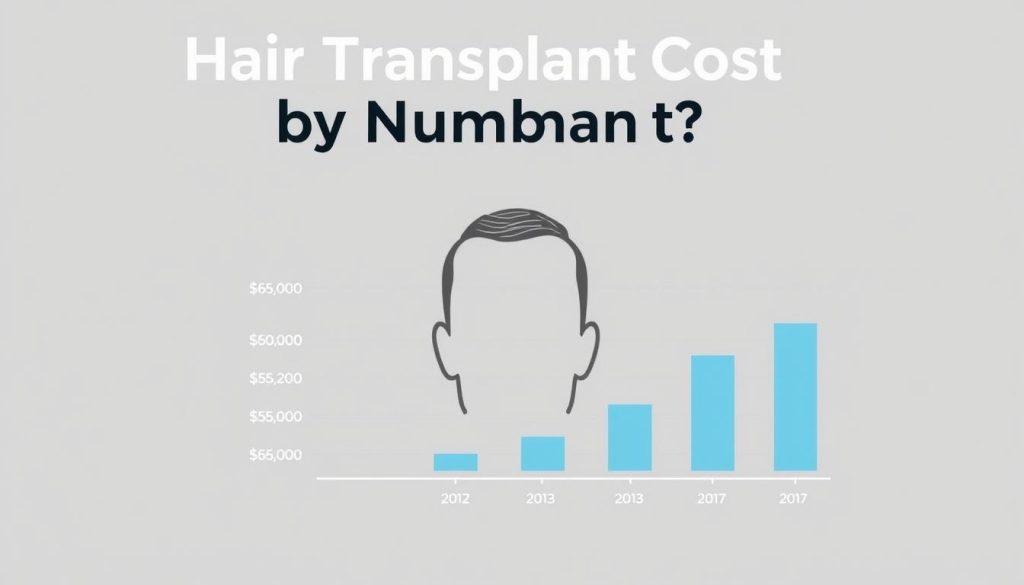A hair transplant is a minimally invasive surgical procedure that has become increasingly popular in the United States as a permanent solution for addressing hair loss and restoring confidence.
The cost of hair transplants in the USA varies significantly based on multiple factors, including geographic location, surgeon expertise, and the specific technique used.
Understanding the price structure of hair transplant procedures helps patients make informed decisions about their hair restoration journey.
Key Takeaways
- The cost of hair transplants in the USA ranges from $4,000 to $15,000.
- Multiple factors influence the final price tag of a hair transplant.
- The initial consultation is crucial in determining the exact cost.
- Patients should be aware that the cheapest option isn’t always the best value.
- The American hair transplant market offers various options at different price points.
Understanding Hair Transplant Procedures
Understanding the nuances of hair transplant techniques is crucial for potential patients. Hair transplant procedures have evolved significantly, offering effective solutions for hair loss.
Follicular Unit Transplantation (FUT)
FUT, also known as the “strip method,” involves removing a strip of scalp from the donor area, typically the back of the head. The strip is then dissected into individual follicular units, which are transplanted to the balding areas. This technique allows for harvesting a large number of grafts in a single session.

Follicular Unit Extraction (FUE)
FUE involves extracting individual follicular units directly from the donor area using a small punch tool. This method results in minimal scarring and quicker recovery times compared to FUT. FUE is more labor-intensive, contributing to its higher cost.

Both FUT and FUE require precision and artistic skill to create natural-looking hairlines and density patterns. Advanced variations include robotic-assisted FUE and automated systems, which can increase precision but add to the overall cost.
Key Factors That Influence Hair Transplant Cost in USA
Understanding the factors that affect hair transplant costs is crucial for patients considering this procedure. The cost of hair transplantation in the USA is influenced by several key elements that patients should be aware of when budgeting for their treatment.

Geographic Location and Clinic Reputation
The geographic location of a clinic plays a significant role in determining the cost of hair transplant procedures. Major metropolitan areas like New York, Los Angeles, and Chicago tend to charge higher prices compared to smaller cities or rural areas. Clinics with established reputations and high success rates generally command higher prices due to their track record of consistent results and patient satisfaction.
Surgeon’s Experience and Qualifications
The surgeon’s experience, qualifications, and specialized training significantly impact the cost of hair transplantation. Board-certified surgeons who specialize exclusively in hair restoration typically charge more for their expertise. Their extensive knowledge and skillset ensure that patients receive high-quality care, justifying the higher costs associated with their services.
Number of Grafts Required
The number of grafts required is a direct determinant of the overall cost of hair transplantation. Most clinics charge on a per-graft basis, so the more grafts needed, the higher the overall cost. The extent of hair loss and the patient’s desired outcome influence the number of grafts required, making this a critical factor in determining the final cost.
Technology and Equipment Used
Advanced technology and equipment, such as robotic-assisted FUE systems or specialized microscopes for graft preparation, contribute to the overall cost of hair transplantation. These technologies enhance the precision and effectiveness of the procedure, but they also add to the facility’s overhead costs, which are reflected in the final price.
- The complexity of the case, including factors like previous transplants, scarring, or challenging hair characteristics, may require additional time and skill, increasing the overall cost.
- The type of anesthesia used and the inclusion of additional treatments like PRP (Platelet-Rich Plasma) therapy can also add to the final price of the procedure.
By understanding these key factors, patients can better navigate the process of determining the cost of their hair transplant procedure and make informed decisions about their care.
Average Hair Transplant Cost in USA by Technique
The cost of hair transplant procedures in the USA varies significantly depending on the technique used. Two primary methods are employed: Follicular Unit Transplantation (FUT) and Follicular Unit Extraction (FUE).
FUT Procedure Pricing
FUT, also known as the strip method, is generally more affordable because it allows surgeons to harvest a larger number of grafts in less time. The average cost for FUT procedures ranges from $4,000 to $10,000 for a standard session, with pricing calculated at $3 to $8 per graft.
In America, prices range from $2 to $10 per FUT graft. On average, the full price of a FUT hair transplant is likely to cost from $12,000 upwards.
FUE Procedure Pricing
FUE procedures command higher prices, typically ranging from $6,000 to $15,000 for a comparable number of grafts, with per-graft pricing between $5 and $10. Advanced FUE variations, such as robotic-assisted procedures, can increase costs by 20-30% compared to manual FUE techniques.
Clinics often offer all-inclusive services, which include aftercare. The cost of FUE hair transplants can vary depending on the clinic and technology used.
Most clinics offer tiered pricing based on the number of grafts, with per-graft rates decreasing as the total number increases. All-inclusive packages may offer better value than per-graft pricing for some patients, as they typically include the consultation, procedure, post-operative medications, and follow-up appointments.
Cost Breakdown by Number of Grafts
The number of grafts required is a primary factor in determining the overall cost of a hair transplant. Procedures are typically categorized as small, medium, or large based on the graft quantity, which significantly influences the total cost.
Small Procedures
Small procedures involving 500-1000 grafts are generally used for minimal recession or thinning. These procedures typically cost between $3,000 and $8,000 in the USA, depending on the technique and clinic. They are often suitable for younger patients experiencing early hair loss or those looking to address specific areas like the hairline or crown.
Medium Procedures
Medium procedures requiring 1500-2500 grafts address moderate hair loss and typically range from $6,000 to $15,000. This is the most common transplant size in the United States. At this graft level, patients can expect significant improvement in density and coverage across the frontal and mid-scalp regions.
Large Procedures
Large procedures involving 3000+ grafts are designed for extensive hair loss and can cost between $10,000 and $25,000 or more, depending on the exact number of grafts and technique used. Many clinics offer tiered pricing structures where the per-graft cost decreases as the total number increases, providing better value for larger procedures.

| Procedure Size | Number of Grafts | Cost Range |
|---|---|---|
| Small | 500-1000 | $3,000 – $8,000 |
| Medium | 1500-2500 | $6,000 – $15,000 |
| Large | 3000+ | $10,000 – $25,000+ |
The relationship between graft numbers and cost is not always linear, as many clinics offer package deals for larger procedures that provide better value than their smaller counterparts. Patients should be aware that multiple sessions might be required for extensive hair loss, potentially increasing the overall cost but allowing for better healing between procedures.
Regional Price Variations Across the USA
The price of hair transplants can fluctuate greatly depending on the region within the United States. This variability is influenced by several factors, including the cost of living, demand for services, and the availability of advanced technologies.
Coastal vs. Inland Pricing
The cost of hair transplants differs significantly between coastal regions and inland areas. East Coast clinics, particularly in cities like New York, Boston, and Washington D.C., tend to charge premium prices, with procedures costing 15-30% more than the national average. Similarly, West Coast markets such as Los Angeles, San Francisco, and Seattle command high prices due to the demand for high-end services and innovative techniques.
- Hair transplant costs vary significantly across different regions.
- East Coast and West Coast clinics charge premium prices.
- The Midwest and Southern states offer more moderate pricing.
Urban vs. Rural Pricing
The disparity in pricing is also notable between major cities and smaller markets. Major cities consistently show higher pricing across all regions, reflecting higher overhead costs and greater competition for experienced surgeons. In contrast, smaller markets and less populated states often offer more competitive pricing, though patients should carefully research the qualifications and results of surgeons in these areas.
- Major cities have higher pricing due to overhead costs.
- Smaller markets offer competitive pricing with careful research.
- Regional variations affect the availability of techniques and technologies.
Some patients travel to different regions for hair transplant procedures, finding that even with travel expenses, the overall cost may be lower. Regional variations also impact the availability of specific techniques and technologies, with cutting-edge approaches often appearing first in major coastal cities.
Hidden Costs to Consider
Beyond the advertised price, several hidden costs can impact the overall investment in hair restoration. Patients should be aware of these additional expenses to budget accurately for their hair transplant procedure.
Consultation Fees
Consultation fees vary widely among clinics, with some charging between $100-$300 for initial evaluations. Other clinics offer free consultations as part of their marketing strategy. It’s essential for patients to clarify whether the consultation fee will be applied to the procedure cost if they decide to move forward.
Post-Operative Medications
Post-operative medications, including pain management drugs, antibiotics, and specialized shampoos, can add $200-$500 to the overall cost. Many clinics do not include these essential medications in their quoted price, requiring patients to purchase them separately.
Follow-Up Appointments
Follow-up appointments for monitoring healing progress and addressing any complications may incur additional charges. These appointments can add several hundred dollars to the total cost over the course of recovery.
Additional Treatments
Additional treatments like Platelet-Rich Plasma (PRP) therapy or prescription medications may be recommended to enhance and maintain results. These complementary treatments can add $1,000-$3,000 annually to the patient’s investment in their hair restoration journey.
By understanding these hidden costs, patients can make a more informed decision about their hair transplant investment and avoid unexpected expenses.
Financing Options and Insurance Coverage
The cost of a hair transplant can be substantial, but there are several financing options and insurance considerations to explore. Most patients need to finance their hair transplant themselves, as it is typically considered a cosmetic procedure.
Making Hair Restoration Affordable
Many clinics partner with third-party medical financing companies like CareCredit, Alphaeon Credit, or Prosper Healthcare Lending. These companies offer specialized healthcare credit lines with promotional interest rates and extended payment terms, making affordable hair restoration more accessible.
Some of the key financing options include:
- Payment plans that allow patients to make a down payment and spread the remaining cost over several months
- Interest-free periods for qualified applicants
- In-house payment plans that do not involve third-party lenders
- Discounts of 5-10% for patients who pay the full amount upfront
Insurance and Hair Transplants
Insurance coverage for hair transplants is extremely rare and typically limited to cases where hair loss resulted from accidents, burns, or certain medical treatments like chemotherapy. Patients seeking insurance coverage must obtain pre-authorization and documentation from their physician establishing medical necessity.
However, patients can use Health Savings Accounts (HSAs) and Flexible Spending Accounts (FSAs) to pay for hair transplant procedures with pre-tax dollars, offering a tax advantage that effectively reduces the overall cost.
Comparing USA Hair Transplant Costs to International Options
When considering hair restoration, the cost difference between undergoing a procedure in the USA versus internationally can be significant. The average cost of a hair transplant in the United States ranges from $4,000 to $15,000, influenced by factors such as the technique used, the surgeon’s expertise, and the clinic’s reputation.
USA vs. Turkey Price Comparison
Turkey has emerged as a leading destination for affordable hair transplants, with costs typically ranging from $1,500 to $3,500. This represents a significant saving compared to the USA, with many Turkish clinics offering all-inclusive packages that cover the procedure, medications, accommodation, and airport transfers. Other countries, such as Mexico, Thailand, and India, also offer competitive pricing, with costs 40-60% lower than in the USA.
- The USA has some of the highest hair transplant costs globally, prompting many patients to explore international options.
- Turkey offers procedures at 30-70% lower costs than in the USA, attracting over 100,000 international patients annually.
- Many Turkish clinics provide comprehensive packages, making the total cost more transparent and manageable.
Quality and Safety Considerations
While cost is a significant factor, quality and safety considerations are paramount when exploring international hair transplant options. Regulatory standards and surgeon qualifications vary significantly between countries. American clinics emphasize their adherence to strict FDA regulations and extensive surgeon training as justifications for their higher rates. Patients must weigh the potential cost savings against the risks associated with international travel for surgery, including variable surgical standards and limited legal recourse in case of complications.
Ultimately, patients must carefully research and consider both the cost and quality of care when deciding between USA and international hair transplant options.
Making an Informed Decision About Your Hair Transplant Investment
Making an informed decision about hair transplant surgery requires careful consideration of multiple factors beyond just the upfront cost, as this investment affects both your appearance and confidence for years to come.
Patients should thoroughly research potential surgeons by reviewing before-and-after photos of previous patients with similar hair loss patterns, checking medical credentials, and reading unbiased reviews from multiple sources. The consultation process is crucial for evaluating not just the surgeon’s expertise but also their communication style and willingness to discuss realistic expectations regarding hair growth outcomes and potential limitations.
It’s essential to consider the clinic’s specialization – facilities that focus exclusively on hair restoration often deliver superior results compared to general cosmetic surgery centers. Long-term value should take precedence over initial price, as a well-performed transplant from a reputable surgeon may cost more upfront but can save money by avoiding corrective procedures for poor results.
Patients should request a detailed breakdown of all costs involved and consider the psychological impact and their personal expectations. A successful hair transplant can significantly improve confidence and self-image, making it a worthwhile investment for many patients struggling with hair loss.
FAQ
What is the difference between Follicular Unit Transplantation (FUT) and Follicular Unit Extraction (FUE)?
FUT involves removing a strip of scalp from the donor area, while FUE involves extracting individual follicular units directly from the donor area. The choice between the two techniques depends on the patient’s needs and the surgeon’s recommendation.
How many grafts are typically required for a hair restoration procedure?
The number of grafts required varies depending on the extent of the patient’s balding area, the density of the donor area, and the desired outcome. On average, a small procedure may require 500-1000 grafts, while a larger procedure may require 3000 or more grafts.
What factors influence the cost of a hair transplant procedure?
The cost is influenced by factors such as the geographic location of the clinic, the surgeon’s experience and qualifications, the number of grafts required, and the technology and equipment used.
Are there any additional costs associated with a hair transplant procedure?
Yes, patients should also consider consultation fees, post-operative medications, follow-up appointments, and potential additional treatments when calculating the total cost.
Do insurance plans typically cover hair transplant procedures?
Generally, insurance plans do not cover hair transplant procedures as they are considered cosmetic. However, some clinics offer financing options or payment plans to help make the procedure more affordable.
How do prices vary across different regions in the USA?
Prices can vary significantly depending on the region, with clinics on the East and West Coasts tend to charge more than those in smaller markets or cities.
What are the benefits of choosing a surgeon with extensive experience in hair restoration?
A surgeon with extensive experience can provide a more natural-looking result, minimize the risk of complications, and ensure a smoother recovery.
Can I finance my hair transplant procedure?
Yes, many clinics offer financing options or payment plans to help make the procedure more affordable. Patients can discuss these options with their chosen clinic.
